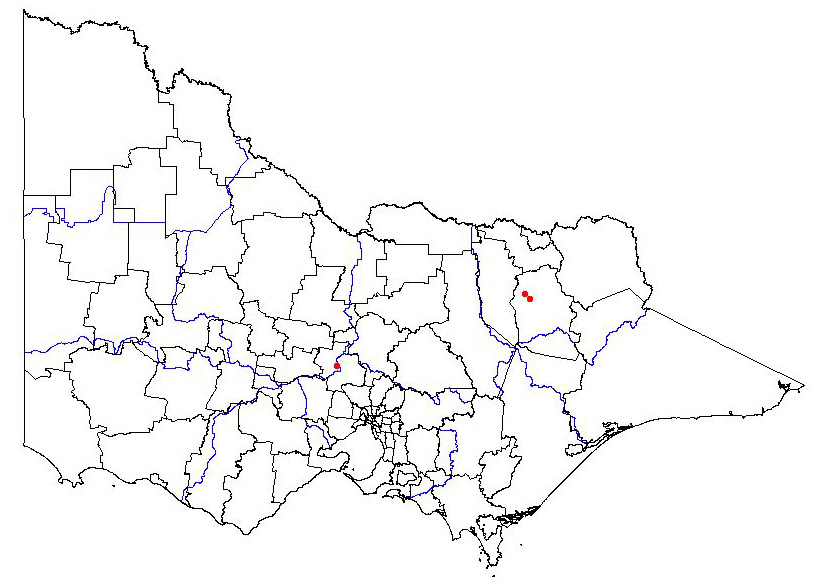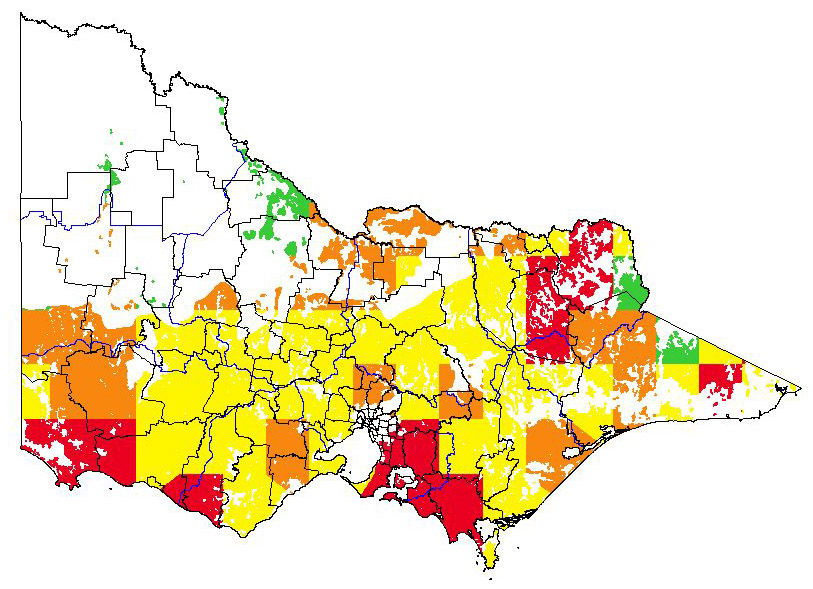Fishbone Cotoneaster (Cotoneaster horizontalis)
Present distribution
|  Map showing the present distribution of this weed. | ||||
| Habitat: Cotoneaster horizontalis has been reported to have invaded pasture in New Zealand (Webb et al 1988). Carr et al (1992) has identified alpine and subalpine vegetation and rock outcrops as vegetation formations with the potential for invasion. Present distribution records from AVH correspond however with pasture dryland and moist foothills forest. | |||||
Potential distribution
Potential distribution produced from CLIMATE modelling refined by applying suitable landuse and vegetation type overlays with CMA boundaries
| Map Overlays Used Land Use: Horticulture; pasture dryland; pasture irrigation Broad vegetation types Coastal grassy woodland; moist foothills forest; montane dry woodland; montane moist forest; sub-alpine woodland; grassland; plains grassy woodland; valley grassy forest; sub-alpine grassy woodland; montane grassy woodland; riverine grassy woodland Colours indicate possibility of Cotoneaster horizontalis infesting these areas. In the non-coloured areas the plant is unlikely to establish as the climate, soil or landuse is not presently suitable. | 
|
Impact
QUESTION | COMMENTS | RATING | CONFIDENCE |
| Social | |||
| 1. Restrict human access? | Is used as a hedging plant (Weller & Ormerod 1996). Therefore able to form dense stands and may require significant works to clear for access. | h | mh |
| 2. Reduce tourism? | Ornamental species may alter the aesthetics. | ml | l |
| 3. Injurious to people? | Cotoneaster berries are poisonous if consumed in large quantities (Shepherd 2004). In 1983-84 1.29% of the reports involving plants made to the Poisons centres in Australia involved a Cotoneaster species (Covacevich, Davie & Pearn 1987). Cotoneaster horizontalis has also been reported in a case of contact dermatitis (Weller & Ormerod 1996). | ml | mh |
| 4. Damage to cultural sites? | Ornamental species may alter the aesthetics. | ml | l |
| Abiotic | |||
| 5. Impact flow? | Terrestrial species | l | m |
| 6. Impact water quality? | Terrestrial species | l | m |
| 7. Increase soil erosion? | Cotoneaster species have been used for soil conservation in their native range (Singh, Bhagwati & Nawa 1992). | l | mh |
| 8. Reduce biomass? | A low growing species used for hedging (Blood 2001 and Weller & Ormerod 1996). Therefore may replace or increase the biomass of the lower stratum. | l | mh |
| 9. Change fire regime? | A low growing species used for hedging (Blood 2001 and Weller & Ormerod 1996). Therefore has potential to increase elevated fuels and therefore fire intensity. | ml | mh |
| Community Habitat | |||
| 10. Impact on composition (a) high value EVC | EVC= Sub-alpine Grassland (V); CMA= North East; Bioreg= Victorian Alps; VH CLIMATE potential. A low growing species used for hedging (Blood 2001 and Weller & Ormerod 1996). Unknown however how much displacement it will cause in natural vegetation. | m | l |
| (b) medium value EVC | EVC= Grassy Woodland (D); CMA= North East; Bioreg= Victorian Alps; VH CLIMATE potential. A low growing species used for hedging (Blood 2001 and Weller & Ormerod 1996). Unknown however how much displacement it will cause in natural vegetation. | m | l |
| (c) low value EVC | EVC= Granitic Hills Woodland (LC); CMA= North East; Bioreg= Victorian Alps; VH CLIMATE potential. A low growing species used for hedging (Blood 2001 and Weller & Ormerod 1996). Unknown however how much displacement it will cause in natural vegetation. | m | l |
| 11. Impact on structure? | A low growing species used for hedging (Blood 2001 and Weller & Ormerod 1996). Unknown however how much displacement it will cause in natural vegetation. | m | l |
| 12. Effect on threatened flora? | Unknown. | mh | l |
| Fauna | |||
| 13. Effect on threatened fauna? | Unknown | mh | l |
| 14. Effect on non-threatened fauna? | Unknown to what extent this species will displace native vegetation and therefore to what extent habitat and food sources will be altered. | m | l |
| 15. Benefits fauna? | Additional food source through berries for bird species (Blood 2001). Dense shrubby vegetation, may be used for nesting sites by bird species (Lu, Zhang & Ren 2003). | m | m |
| 16. Injurious to fauna? | Does have toxic properties, toxic to people (Shepherd 2004). However no detrimental effects to fauna reported, birds eat and disperse the berries (Blood 2001). | l | m |
| Pest Animal | |||
| 17. Food source to pests? | Red berries attractive to frugivorous bird species (Blood 2001). | ml | mh |
| 18. Provides harbor? | Cotoneaster species have been reported used as nesting sites by turtle-doves (Lu, Zhang & Ren 2003). Hedging species (Weller & Ormerod 1996). Dense growth may provide shelter for foxes and rabbits | m | m |
| Agriculture | |||
| 19. Impact yield? | Reported in pasture, (Webb, Sykes & Garnock-Jones 1988). May therefore reduce the production area. | l | m |
| 20. Impact quality? | Not an agricultural weed | l | m |
| 21. Affect land value? | Not an agricultural weed | l | m |
| 22. Change land use? | Not an agricultural weed | l | m |
| 23. Increase harvest costs? | Not an agricultural weed | l | m |
| 24. Disease host/vector? | Susceptible to insect pests common to fruit trees of Britain (Wilson 1945). | m | mh |
Invasive
QUESTION | COMMENTS | RATING | CONFIDENCE |
| Establishment | |||
| 1. Germination requirements? | For propagation of cotoneaster species, seed is recommended to be sown in autumn, or stratified over winter and then sown under glass in spring (Griffths 1992). During a study on the seed treatments of this species a large proportion of seeds germinated when exposed to higher outside temperatures of May-September of the northern hemisphere (Spring, early summer germination) (Blomme & Degeyter 1985). | mh | h |
| 2. Establishment requirements? | Recommended for full sun to partial shade (Dave’s Garden 2006). | mh | m |
| 3. How much disturbance is required? | Reported to invade alpine vegetation (Carr, Yugovic and Robinson 1992). | h | mh |
| Growth/Competitive | |||
| 4. Life form? | Shrub (Carr, Yugovic and Robinson 1992). | l | mh |
| 5. Allelopathic properties? | No reported for this species, however C. salicifolius has been reported to allelopathic potential (Morita, Ito & Harada 2005). | m | l |
| 6. Tolerates herb pressure? | Not reported grazed, tolerant of pruning (Weller & Ormerod 1996). | mh | mh |
| 7. Normal growth rate? | Other Cotoneaster species have been reported to be fast growing (PFAF 2002). However this is a lower growing species and therefore may not be as competitive. | m | m |
| 8. Stress tolerance to frost, drought, w/logg, sal. etc? | Tolerant of frost (Dave’s Garden 2006). Other Cotoneaster species have been reported drought tolerant (PFAF 2002). Not affected by soil salinity of 12 mS cm –1 (Marosz 2004). Susceptible of waterlogging (Dave’s Garden 2006). | mh | m |
| Reproduction | |||
| 9. Reproductive system | Reproduces sexually, producing seed (Blomme & Degeyter 1985). Cotoneaster species are capable of layering, where branches that are in constant contact with the ground can set root (Bossard, Randell & Hoshovsky 2000). | h | mh |
| 10. Number of propagules produced? | Other cotoneaster species have been reported to produce abundant fruit, each containing 1-3 seeds (Weber 2003). | h | m |
| 11. Propagule longevity? | Due to the seeds germinating after a 14 month stratification study on C. horizontalis, seed viability was at 38% (Blomme & Degeyter 1985). Unknown however how long a seed can remain viable. | m | m |
| 12. Reproductive period? | As a garden plant a specimen has been reported as more than 25 years old (Dave’s Garden 2006). | h | ml |
| 13. Time to reproductive maturity? | Unknown | m | l |
| Dispersal | |||
| 14. Number of mechanisms? | Produces red berries, which are then dispersed by birds, animals and water (Blood 2001 and Carr, Yugovic and Robinson 1992). | h | mh |
| 15. How far do they disperse? | Birds and animals can disperse fruit seeds distances greater than 1km (Spennemann & Allen 2000). | h | mh |
References
Blomme R. & Degeyter L., 1985, Seed treatments and germination determinations for seeds of Cotoneaster horizontalis. Verbondsnieuws voor de Belgische Sierteelt. 29: 17-23
Blood K., 2001, Environmental Weeds. A field guide for SE Austalia. CH Jerram & Associates – Science publishers. Mt Waverly.
Bossard C.C., Randell J.M. & Hoshovsky M.C., 2000, Invasive plants of California’s wildlands. University of California Press.
Carr G.W., Yugovic J.V. and Robinson K.E.,, 1992, Environmental weed invasions in Victoria: conservation and management implications, Department of Conservation and Environment, Clifton Hill.
Covacevich J., Davie P. & Pearn J., 1987, Toxic plants & animals. A guide for Australia. Queensland Museum. Brisbane
Dave’s Garden: Dave’s Garden “For Gardeners… By Gardeners”. viewed 18Dec 2006, http://davesgarden.com/
Griffths M., 1992, The new Royal Horticultural Society dictionary of gardening. Macmillan. London
Lu X., Zhang L.Y., & Ren C., 2003, Breeding ecology of the rufous turtle dove (Streptopelia orientalis) in mountain scrub vegetation, Lhasa (Tibet). Game & Wildlife Science. 20: 225-240
Marosz A., 2004, Effect of soil salinity on nutrient uptake, growth, and decorative value of four ground cover shrubs. Journal of Plant Nutrition. 27: 977-989
Morita S., Ito M. & Harada J., 2005, Screening of an allelopathic potential in arbor species. Weed Biology and Management. 5: 26-30
PFAF: Plants for a Future. Edible, medicinal and useful plants for a healthier world. viewed 6 Jul 2001, http://pfaf.org/
Shepherd R.C.H., 2004, Pretty but poisonous. Plants poisonous to people, an Illustrated Guide for Australia. R.G. and F.J. Richardson. Meredith
Singh R.P., Bhagwati P. & Nawa B., 1992, Cotoneaster microphylla Wall. – suitable for soil conservation in temperate regions of Himalayas. Indian Forester. 118: 672-675
Spennemann. D.H.R. & Allen. L.R., 2000, Feral olives (Oliea europaea) as future woody weeds in Australia: a review. Australian Journal of Experimental Agriculture. 40: 889-901.
Weber, E. 2003, Invasive plant species of the world: a reference guide to environmental weeds, CABI Publishing, Wallingford.
Webb C.J., Sykes W.R. & Garnock-Jones P.J., 1988, Flora of New Zealand, Vol 4, Botany Division, Department of Scientific & Industrial Research, New Zealand.
Weller R.& Ormerod A., 1996, Contact dermatitis from cotoneaster. Contact Dermatitis. 34: 433-434
Wilson G.F., 1945, Insect pests of Cotoneaster horizontalis. Journal of the Royal Horticultural Society. 70: 25-27
Global present distribution data references
Australian National Herbarium (ANH) 2006, Australia’s Virtual Herbarium, Australian National Herbarium, Centre for Plant Diversity and Research, viewed 4 Dec 2006 , http://www.anbg.gov.au/avh/
FIS: Flora Information System 2005. Department of Sustainability and Environment.
Global Biodiversity Information Facility (GBIF) 2006, Global biodiversity information facility: Prototype data portal, viewed 1 Dec 2006, http://www.gbif.org/
Missouri Botanical Gardens (MBG) 2006, w3TROPICOS, Missouri Botanical Gardens Database, viewed 1 Dec 2006, http://mobot.mobot.org/W3T/Search/vast.html
Feedback
Do you have additional information about this plant that will improve the quality of the assessment?
If so, we would value your contribution. Click on the link to go to the feedback form.


